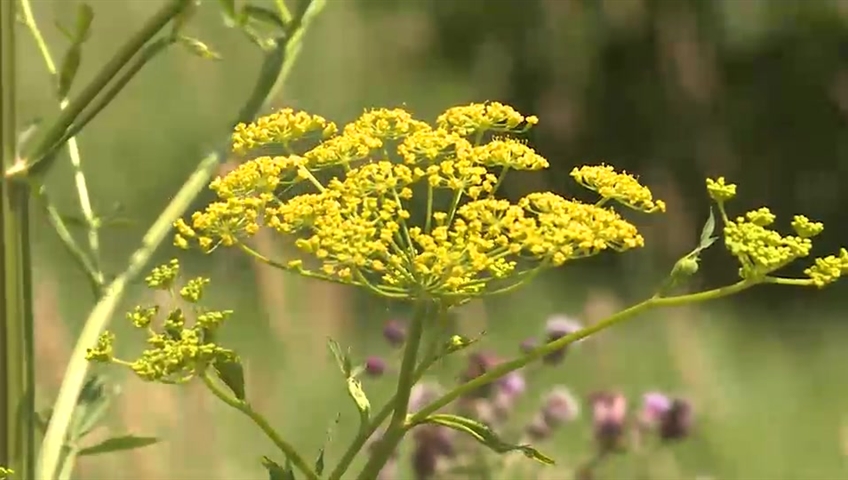A 21-year-old Vermont woman is warning others to steer away from the invasive wild parsnip plant after she was hospitalized with severe burns and blisters from coming in contact with it.

The wound was so bad it was comparable to a second-degree chemical burn.
In a detailed Facebook post, Charlotte Murphy described how she came in contact with the wild plant at the beginning of July. She said she accidentally slid into the brush on the side of the road and broke the plant.
At the time she said she didn’t realize her leg rubbed against its broken leaves, which was oozing oil. Unfazed, she went on about the day in the hot sun, “thus activating the plant oil even more,” she added.
Wild parsnip, which is similar to giant hogweed, produces a poisonous sap which causes the skin to become extremely sensitive to sunlight, leading to severe burns and blisters.
WARNING: Disturbing image of the burn and blister is below. Discretion is advised.
At first, a few bumps appeared but there wasn’t any itching or pain.
“I continued working out in the sun allowing more sweat and UV rays to hit the skin, making the reaction that came a week later much worse than if I had washed my skin right away and stayed out of the sun,” she said on the Facebook post.
A week later, the redness increased and the itching began. Murphy said she started to scratch it in her sleep and woke up with blisters on her leg. Throughout the day the sores grew to a point that her leg was swollen and couldn’t walk.
She was then rushed to a nearby hospital. Unable to drain the big blister on her lower left leg, the clinic bandaged her legs and gave Murphy antibiotics, according to Fox News.
WARNING: Disturbing image below. Picture of the burn and blister.
She returned to urgent care over the next couple of days where doctors monitored her condition. Murphy also went to a trauma and burn center, which helped treat the wounds.
“The progress is slow but the blisters and swelling have gone down and I am now getting my wounds treated at (Vermont’s) UVM burn clinic, as the plant has produced a burn comparable to a 2nd degree chemical burn,” she said,
Murphy is expected to make a full recovery but may have scarring on her leg, according to Fox News.
Now she is hoping her story will teach others about the danger of the wild parsnip plant.
“My hope in posting this unfortunate news is to create greater awareness for what WILD PARSNIP is … and the terrible things the OIL from its stem, leaves, and blooms can do to the skin (I’m not saying everyone will have the reaction I did) and to encourage people to spread the news,” she wrote,
“Please be on the lookout the rest of the summer and get help immediately if you come in contact with its oil!”
WATCH: Teenage boy suffers from painful blisters after coming into contact with wild parsnip
Wild parsnip: where to find it
Wild parsnip is an invasive plant commonly found in Canada that has been known to cause severe burns. The roots are edible, but the sap of the plant can cause blisters and severe burns when mixed with sun exposure.
Since brought by European settlers, wild parsnip has escaped from cultivated gardens and spread across North America. It’s been reported throughout Canada, except in Nunavut, and is often mistaken as the harmless Queen Anne’s Lace.
The plants also grow quickly, forming dense stands, especially in disturbed areas. Seeds are dispersed by wind, water and on vehicles and equipment. It can become a problem, usually in abandoned agricultural areas, according to the Ontario government.
So, how can you tell if it’s wild parsnip?
- It grows up to 1.5 metres tall.
- The single green stem is two-to-five centimetres thick and smooth with few hairs.
- Compound leaves are arranged in pairs, with sharp-toothed leaflets that are shaped like a mitten.
- Yellowish green flowers form umbrella-shaped clusters 10 to 20 centimetres across.
If you find the plant on your property, you should contact your city to identify it and avoid contact at all cost.
READ MORE: Toxic plant causing a stir in Toronto
If you are unsure if you’ve made contact with wild parsnip, you should wash your skin thoroughly, and if you see irritation or feel a burning sensation, you must seek medical attention, according to health officials.
- Capital gains changes are ‘really fair,’ Freeland says, as doctors cry foul
- Ontario doctors offer solutions to help address shortage of family physicians
- ‘Dangerous message’: Experts slam anti-sunscreen claims circulating online
- ‘Trying not to die’: Tourism operators loaded with debt despite rising demand






Comments